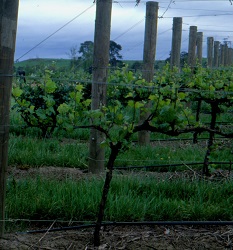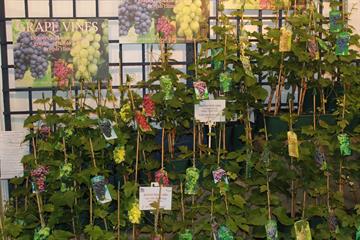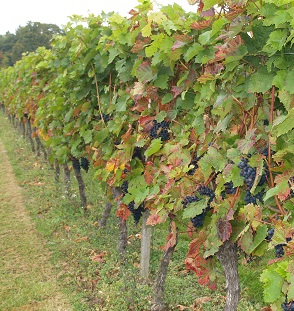Learn to Manage or work in a vineyard
 Do you want to start your own vineyard?
Do you want to start your own vineyard?
- Increase your knowledge of viticulture
- Study horticulture to provide you with a greater depth of knowledge in growing and managing plants and crops.
- A course designed for people working, or intending to work, in grape production.
- The course is structured in two parts - the core units provide a detailed foundation of studies in horticulture, and these are then followed by specialist stream units focusing on the production of grapes for wine, drying, or fresh fruit.
- In addition to assignments throughout the course, to pass the Certificate In Horticulture (Viticulture) students are to sit and pass two exams for the core studies and two for the stream. (Course fees do not include exam fees).
- Options to spread course payments over 4 instalments - the single payment is discounted over the instalment options, in addition, a 5% discount is given for the online study method option.
Course Content and Structure
Half of the course (the Core) provides a broad based foundation that is relevant to both growing grapes or growing any other type of plant. This broad foundation is important in two respects:
- It will give you a broader perspective on the world in which we grow grapes, helping you to appreciate different climates, different techniques, and the science that underpins all good horticulture.
- It will give you the capacity to adapt and earn an income from more than just growing grapes, if your interests or needs change throughout your career.
The second half of the course (the Stream), is squarely focused on growing grapes and other aspects of working in Viticulture. It gives you a very sound foundation for a business or employment in this industry.
The Core Units comprise fifteen lessons and are divided into the following sections:
- Introduction to Plants
- Plant Culture
- Soils and Nutrition
- Plant Identification and Use
- Pests, Diseases and Weeds
CORE STUDIES
Core lessons are grouped into the following units.
1. Introduction to Plants (40 hours)
The purpose of this study area is to explain the binomial system of plant classification and demonstrate identification of plant species through the ability of using botanical descriptions for leaf shapes and flowers.
Aims:
- Describe the relevant identifying physical features of flowering ornamental plants.
- Demonstrate how to use prescribed reference books and other resources to gain relevant information.
- Dissect, draw and label two different flowers.
- Collect and identify the shapes of different leaves.
- Demonstrate how to identify between family, genus, species, variety and cultivar.
2. Plant Culture (60 hours)
The purpose of this study area is to demonstrate the ability to care for plants so as to maintain optimum growth and health while considering pruning, planting, and irrigation.
Aims:
 Describe how to prune different plants.
Describe how to prune different plants.- Demonstrate how to cut wood correctly, on the correct angle and section of the stem.
- Describe how to plant a plant.
- Demonstrate an awareness of different irrigation equipment, sprinklers, pumps and turf systems available by listing their comparative advantages and disadvantages.
- Demonstrate competence in selecting an appropriate irrigation system for a garden, explaining why that system would be preferred.
- Define water pressure and flow rate and how to calculate each.
- Explain the need for regular maintenance of garden tools and equipment.
- List factors that should be considered when comparing types of machinery for use in garden maintenance.
3. Soils and Plant Nutrition (50 hours)
The purpose of this study area is to provide students with the skills and knowledge to identify, work with, and improve the soil condition and potting mixes, and to evaluate fertilisers for use in landscape jobs to maximise plant growth.
Aims:
- Describe the soil types commonly found in plant culture in terms of texture, structure and water-holding and nutrient holding capacity.
- Describe methods of improving soil structure, infiltration rate, water holding capacity, drainage and aeration.
- List the elements essential for plant growth.
- Diagnose the major nutrient deficiencies that occur in ornamental plants and prescribe treatment practices.
- Describe soil pH and its importance in plant nutrition.
- Describe the process by which salting occurs and how to minimise its effect.
- Conduct simple inexpensive tests on three different potting mixes and report accordingly.
- Describe suitable soil mixes for container growing of five different types of plants.
- List a range of both natural and artificial fertilisers.
- Describe fertiliser programs to be used in five different situations with ornamental plants.
4. Introductory Propagation (40 hours)
The purpose of this study area is to improve the student's understanding of propagation techniques with particular emphasis on cuttings and seeds. Other industry techniques such as grafting and budding are also explained.
Aims:
- Demonstrate propagation of six (6) different plants by cuttings and three from seed.
- Construct a simple inexpensive cold frame.
- Mix and use a propagation media suited to propagating both seed and cuttings.
- Describe the method and time of year used to propagate different plant varieties.
- Describe and demonstrate the steps in preparing and executing a variety of grafts and one budding technique.
- Explain the reasons why budding or grafting are sometimes preferred propagation methods.
5. Identification and Use of Plants (60 hours)
The purpose of this study area is to improve the student's range of plant knowledge and the plant use in landscaping and the ornamental garden, and the appreciation of the different optimum and preferred growing conditions for different plants.
Aims:
- Select plants appropriate for growing in different climates.
- Select plants appropriate to use for shade, windbreaks, as a feature, and for various aesthetic effects.
- Categorise priorities which effect selection of plants for an ornamental garden.
- Explain the differences in the way plants perform in different microclimates within the same area.
- List and analyse the situations where plants are used.
6. Pests, Diseases and Weeds (50 hours)
The purpose of this study area is develop the student’s ability to identify, describe and control a variety of pests, diseases and weeds in ornamental situation, and to describe safety procedures when using agricultural chemicals.
Aims:
- Explain in general terms the principles of pest, disease and weed control and the ecological (biological) approach to such control.
- Explain the host pathogen environment concept.
- Describe a variety of pesticides for control of pests, diseases and weeds of ornamental plants in terms of their active constituents, application methods, timing and rates, and safety procedures.
- Photograph or prepare specimens, identify and recommend control practices for at least five insect pests of ornamental plants.
- Photograph, sketch or prepare samples, identify and recommend control practices for three non insect ornamental plant health problems (e.g. fungal, viral, bacterial).
- Describe the major ways in which diseases (fungal, viral, bacterial and nematode) affect turf, the life cycle features that cause them to become a serious problem to turf culture and the methods available for their control.
- Identify, describe and recommend treatment for three different weed problems.
- Collect, press, mount and identify a collection of ten different weeds, and recommend chemical and non-chemical treatments which may be used to control each.
- List and compare the relative advantages and disadvantages of different weed control methods.
STREAM STUDIES
The Viticulture stream is divided into the following:
 Introduction to Viticulture
Introduction to Viticulture- Introduction to Grapevines
- Propagation of Grapevines
- Improving Grape Quality
- Climate and Other Factors In Siting Vineyards
- Grape Varieties and Selection
- Establishing a Vineyard
- Harvest and Post-harvest Handling
- Managing A Vineyard
- Machinery and Equipment
- Irrigation
- Plant Nutrition
- Agricultural Chemicals
- Supervision
- Increasing Efficiency
Stream Unit Aims:
 Describe the nature and scope of the Viticulture industry throughout the world.
Describe the nature and scope of the Viticulture industry throughout the world.- Explain the physiology of the grape and the physiological processes of the plant.
- Outline propagation techniques used for grapevines.
- Describe the processes behind the improvement of grape quality (including pest and disease problems).
- Outline the climatic and other factors that should be considered in selecting a site for a vineyard.
- Describe commonly grown grape varieties that would and would not be suitable for growing in your area.
- Develop a procedure to establish a vineyard.
- Outline the harvesting and post handling procedures for grapes.
- Outline the management procedures and work program for a vineyard.
- Describe the type of equipment you will need to set and manage a vineyard.
- Outline irrigation equipment and procedures required in a vineyard.
- Explain plant nutritional requirements and outline a fertiliser program for a vineyard.
- Outline the characteristics of pesticides and herbicides and health and safety procedures for their use.
- Outline the supervisory structure in a vine yard.
- Outline methods of how to increase efficiency in a vineyard.
What is a Grape?
 Grapes belong to the Vitaceae family. Within this family, only the genus Vitis is of any great interest to viticulture, although four of the nine genera in this family yield grapes. The Vitis genus includes some 60 to 80 evergreen and deciduous shrubs, mainly of a climbing habit, supporting themselves by tendrils.
Grapes belong to the Vitaceae family. Within this family, only the genus Vitis is of any great interest to viticulture, although four of the nine genera in this family yield grapes. The Vitis genus includes some 60 to 80 evergreen and deciduous shrubs, mainly of a climbing habit, supporting themselves by tendrils.
Almost all commonly cultivated grapevines belong to the species Vitis vinifera, although other species have some use in viticulture: for rootstocks, materials for hybridisation and, in some circumstances, for actual grape production. The commonly grown grape vine (Vitis vinifera – also known as the European Grape) originated from Asia Minor and has been carried with civilisation for thousands of years throughout history. Vitis vinifera was taken to Mexico by the Spaniards. English settlers took Old World grapes with them and planted them along the Atlantic seaboard.
These however failed due to the presence of the insect phylloxera, and fungus diseases like Black Rot, Downy Mildew and Powdery Mildew, as well as deleterious effect of low winter temperatures and hot humid summers.
Vitis vinifera requires a warm temperate climate, with minimum temperatures of -2°C while dormant,
-1°C at bud burst and -0.5°C when in full flower. The root system is deep, and as such can draw water from lower levels of the soil; hence the need for high rainfall or irrigation is only moderate. Effective irrigation methods in suitable climates can, however, improve quality and quantity of yields.
The vine does not tolerate wet soils in summer but will tolerate some wetness in winter.
When on a trellis it will tolerate wind reasonably well, but not strong gale force winds. Though sandy soils are preferred, grapes will tolerate most soils provided they are deep and well drained.
Some other grape species that are of significance to viticulture include:
 Vitis amurensis
Vitis amurensis- Vitis labrusca
- Vitis riparia
- Vitis rupestris
- Vitis berlandeieri
- Vitis aestivalis
- Vitis cinerea
- Vitis rotundifolia
The Genera Vitis and Muscadinia
Plants from both of these genera are called “grapes”. The world viticulture industry concentrates on growing cultivars of Vitis vinifera. Cultivars of other species from both genera are however grown for edible fruit in various parts of the world.
Vitis has forked tendrils, sheds its bark, has a diaphragm (continuous pith) at the nodes, and elongated clusters with berries that stick to the pedicels at maturity.
Muscadinia has tight bark that does not shed, simple tendrils that do not fork, nodes without a diaphragm, and small clusterlets with berries that detach as they mature.
Vitis vinifera also have intermittent tendrils, thin, smooth shiny leaves with 3, 5, or 7 lobes. The berry size varies.
Species used for grape production
Vitis vinifera cultivars produce over 90% of the world's grapes, whether as pure vinifera or hybridised. The most important grape species used in North America are:
- Vitis labrusca - Concord, Niagara
- Vitis aestivalis - Norton, Delaware
- Vitis vulpina - Elvira, Clinton
- Vitis rotundifolia - Scuppernong, Eden, Muscadine
- Vitis rupestris - Rupestris St. George
The Concord variety makes about 80% of the total American production. Many grape varieties have been crossbred between species and even other hybrids to produce improved characteristics of the fruit, growth habit or even disease resistance.
Root stocks
Root stocks that exhibit resistance to phylloxera have become invaluable in the industry. Some of the American species used as root stock that have resistance are Vitis riparia, Vitis berlandieri, Vitis rupestris, Vitis aestivalis, Vitis cordifolia, and Vitis monticola.
Rootstocks that exhibit resistance to nematodes are also important. These include from America: Vitis rotundifolia, Vitis champini, Vitis candicans, and Vitis long.
An International Industry
The wine industry is truly international, with different countries recognised for certain grape varieties and styles of wine, to others aiming for particular value areas of the consumer market. Factors such as location, climate, environment, and soils will determine what types of grape variety are most appropriate for the vineyard.
Studying the Certificate In Horticulture (Viticulture) will provide you with a solid introduction to the wine industry, developing your knowledge of different grape varieties, how to grow them, how to manage them, and what processes you need to follow for harvesting your crop. Allied to this will be the valuable horticultural knowledge that you have developed in the first part of this course. This place you in a better position when managing your crops, but also provides you with the knowledge to consider other crop options in the future should you need to.
Our Students Say
"[The course] gave me extra knowledge of the industry that I am currently working in. It covered all aspects of the industry. I liked the way you had to work through each lesson/category I received excellent feedback from my tutor. I enjoyed the viticulture course, it has given me extra knowledge that I will use."James McKelvey, Vineyard Manager, Viticulture course.
Learn from Experts
The Certificate In Horticulture (Viticulture) has been developed by and is taught by highly knowledgeable experts. Students benefit from their support and guidance throughout their studies with us.
With ACS you also benefit from a very flexible approach to studies - our courses can be started at any time. They are self-paced meaning that you can fit your studies around your other work and life commitments. In addition, you have the options of eLearning or online studies - meaning you could even be studying in the middle of a vineyard if you so choose!
If you have any questions about the course, studying with ACSs, or you need help and guidance in selecting a plan of study to suit your goals, then get in touch using our Free Course Counselling Service. We will be pleased to help you.